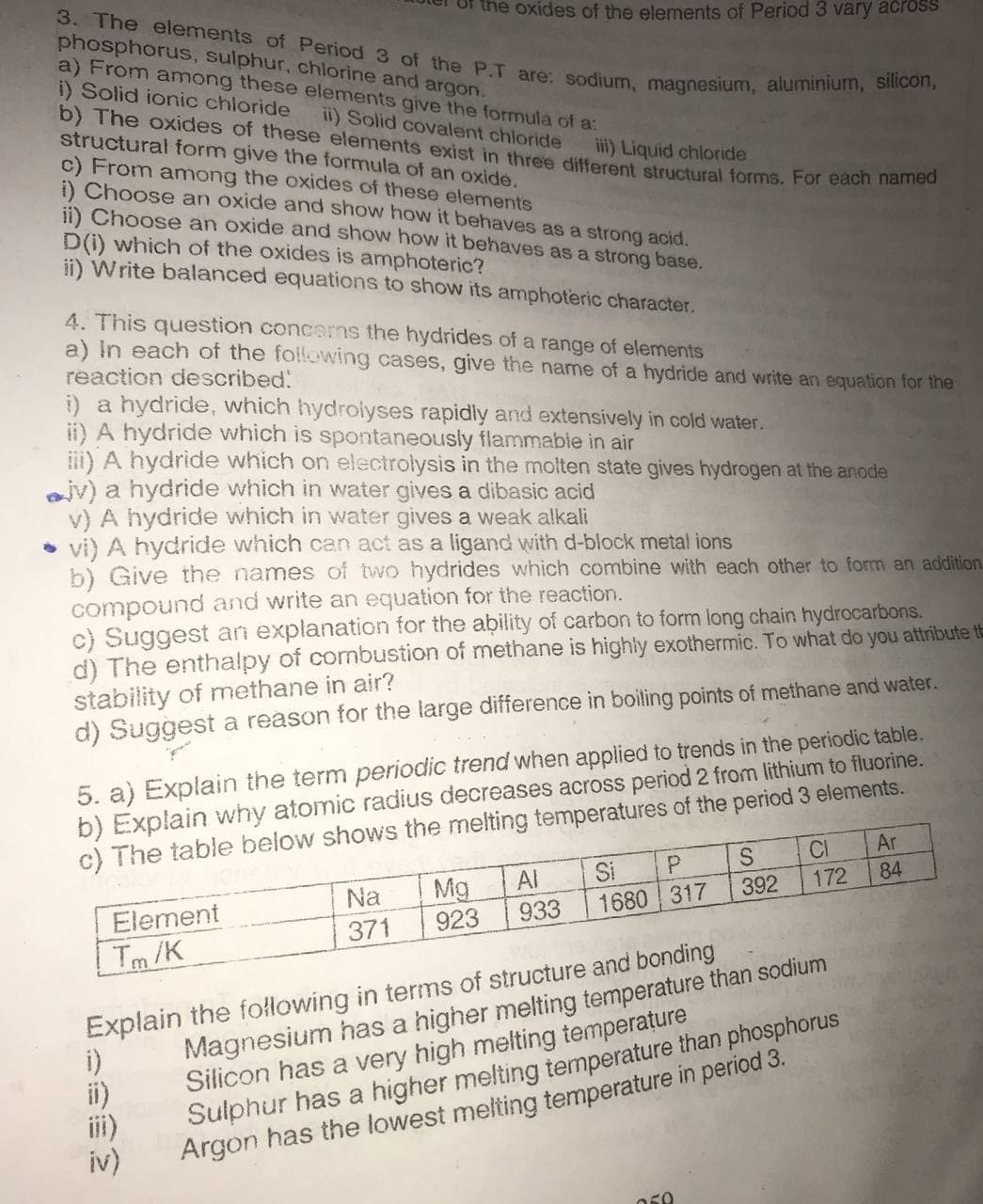Explain the following in terms of structure and Magnesium has a higher melting temperature than sodium a very high melting temperature tomnerature than phosphorus oriod 3.
Explain the following in terms of structure and Magnesium has a higher melting temperature than sodium a very high melting temperature tomnerature than phosphorus oriod 3.
Chemistry & Chemical Reactivity
10th Edition
ISBN:9781337399074
Author:John C. Kotz, Paul M. Treichel, John Townsend, David Treichel
Publisher:John C. Kotz, Paul M. Treichel, John Townsend, David Treichel
Chapter21: The Chemistry Of The Main Group Elements
Section: Chapter Questions
Problem 119IL
Related questions
Question
Q5c(i)

Transcribed Image Text:3. The elements of Period 3 of the P.T are: sodium, magnesium, aluminium, silicon,
phosphorus, sulphur, chlorine and argon.
a) From among these elements give the formula of a:
i) Solid ionic chloride
b) The oxides of these elements exist in three different structural forms. For eacn han
structural form give the formula of an oxide.
c) From among the oxides of these elements
i) Choose an oxide and show how it behaves as a strong acid.
ii) Choose an oxide and show how it behaves as a strong base.
D(i) which of the oxides is amphoteric?
ii) Write balanced equations to show its amphoteric character.
the oxides of the elements of Period 3 vary across
ii) Solid covalent chloride
iii) Liquid chloride
4. This question concerns the hydrides of a range of elements
a) In each of the following cases, give the name of a hydride and write an equation for the
reaction described!
i) a hydride, which hydroiyses rapidly and extensively in cold water.
ii) A hydride which is spontaneously flammabie in air
ii) A hydride which on electrolysis in the molten state gives hydrogen at the anode
jv) a hydride which in water gives a dibasic acid
v) A hydride which in water gives a weak alkali
• vi) A hydride which can act as a ligand with d-block metal ions
b) Give the names of two hydrides which combine with each other to form an addition.
compound and write an equation for the reaction.
c) Suggest an explanation for the ability of carbon to form long chain hydrocarbons.
d) The enthalpy of combustion of methane is highly exothermic. To what do you attribute t
stability of methane in air?
d) Suggest a reason for the large difference in boiling points of methane and water.
5. a) Explain the term periodic trend when applied to trends in the periodic table.
b) Explain why atomic radius decreases across period 2 from lithium to fluorine.
c) The table below shows the melting temperatures of the period 3 elements.
CI
Ar
Al
Si
84
Mg
923
Na
392
172
Element
933
1680 317
371
Tm /K
Explain the following in terms of structure and bonding
i)
ii)
ii)
iv)
Magnesium has a higher melting temperature than sodium
Silicon has a very high melting temperature
Sulphur has a higher melting temperature than phosphorus
Argon has the lowest melting temperature in period 3.
Expert Solution
This question has been solved!
Explore an expertly crafted, step-by-step solution for a thorough understanding of key concepts.
Step by step
Solved in 2 steps

Knowledge Booster
Learn more about
Need a deep-dive on the concept behind this application? Look no further. Learn more about this topic, chemistry and related others by exploring similar questions and additional content below.Recommended textbooks for you

Chemistry & Chemical Reactivity
Chemistry
ISBN:
9781337399074
Author:
John C. Kotz, Paul M. Treichel, John Townsend, David Treichel
Publisher:
Cengage Learning

Chemistry & Chemical Reactivity
Chemistry
ISBN:
9781133949640
Author:
John C. Kotz, Paul M. Treichel, John Townsend, David Treichel
Publisher:
Cengage Learning

Chemistry
Chemistry
ISBN:
9781305957404
Author:
Steven S. Zumdahl, Susan A. Zumdahl, Donald J. DeCoste
Publisher:
Cengage Learning

Chemistry & Chemical Reactivity
Chemistry
ISBN:
9781337399074
Author:
John C. Kotz, Paul M. Treichel, John Townsend, David Treichel
Publisher:
Cengage Learning

Chemistry & Chemical Reactivity
Chemistry
ISBN:
9781133949640
Author:
John C. Kotz, Paul M. Treichel, John Townsend, David Treichel
Publisher:
Cengage Learning

Chemistry
Chemistry
ISBN:
9781305957404
Author:
Steven S. Zumdahl, Susan A. Zumdahl, Donald J. DeCoste
Publisher:
Cengage Learning


Chemistry: An Atoms First Approach
Chemistry
ISBN:
9781305079243
Author:
Steven S. Zumdahl, Susan A. Zumdahl
Publisher:
Cengage Learning

Chemistry: Principles and Practice
Chemistry
ISBN:
9780534420123
Author:
Daniel L. Reger, Scott R. Goode, David W. Ball, Edward Mercer
Publisher:
Cengage Learning